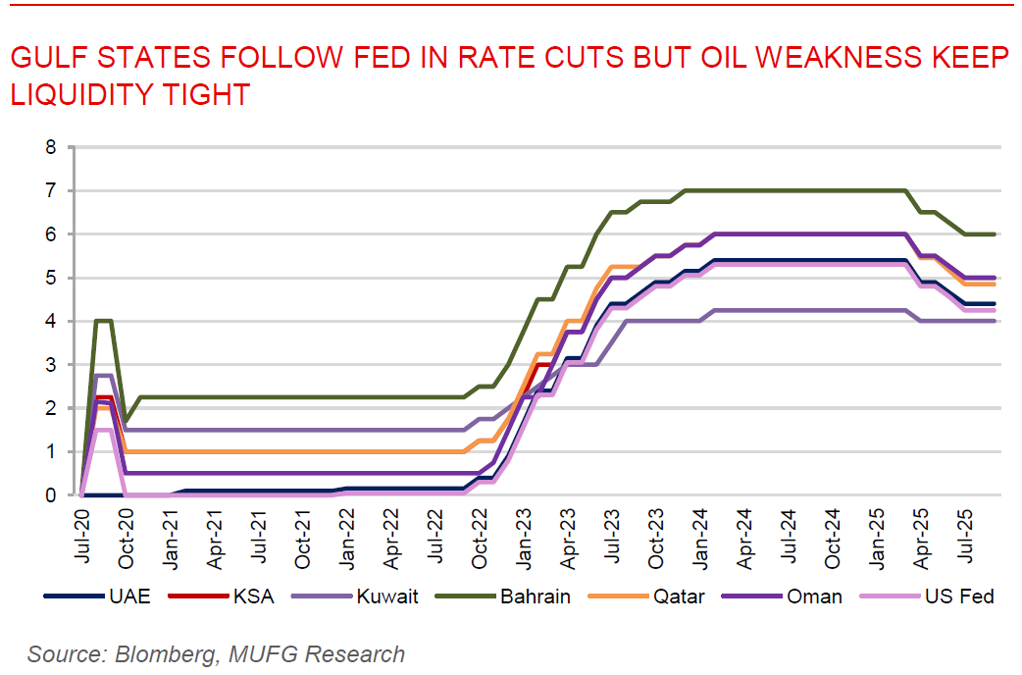To read the full report, please download the PDF above.
Middle East Daily
SOOJIN KIM
Research Analyst
DIFC Branch – Dubai
T: +44(4)387 5031
E: soojin.kim@ae.mufg.jp
MUFG Bank, Ltd. and MUFG Securities plc
A member of MUFG, a global financial group
Middle East Daily
COMMODITIES / ENERGY
Oil holds decline as Fed cut and US inventory data weighed. Oil prices extended losses, with Brent slipping below USD68/b and WTI near USD64/b, as traders balanced a widely anticipated 25bps Fed cut against signs of softer US fuel demand. While lower interest rates generally support consumption, markets had already priced in the move, leading to a pullback after hedges were unwound. Crude remains stuck in the middle of a USD5 trading range that has persisted since early August, caught between geopolitical risks, including Ukrainian strikes on Russian energy infrastructure and OPEC+ supply returning faster than expected, and bearish demand concerns tied to US tariffs. US data showed a 9.29 million-barrel draw in crude inventories, the steepest in three months, driven by higher exports, but the rise in distillate stockpiles to their highest level since January and a large adjustment factor tempered the bullish signal, keeping sentiment cautious.
Gold slips after Fed rate cut despite record spike. Gold retreated after briefly surging to a new record of USD3,707/oz when the Fed cut rates by 25bps and signalled two more reduction this year. While lower borrowing costs typically support gold, the metal closed 0.8% lower as investors judged the Fed’s guidance less dovish than anticipated. Chair Powell highlighted tariff-driven inflation risks and stressed a “meeting-by-meeting” approach to further cuts, sending Treasuries lower and the dollar higher, weighing on gold. Despite the dip, gold remains up nearly 40% this year, underpinned by safe-haven demand from trade and geopolitical tensions, robust central bank buying, and ETF inflows. We expect the rally extending as high as USD4,050/oz in the coming year.
MIDDLE EAST - CREDIT TRADING
End of day comment – 17 September 2025. Mixed session overall. Buying and selling flows overall were balanced, but the morning was somewhat more constructive than the afternoon. There was a bit of dealer position squaring ahead of the FOMC, but that wasn't sizeable as dealer positioning still feels light overall. IG names again outperformed higher beta names. Especially the IG sovereign curves have very little offer side liquidity. ADGB closed around 3bp tighter, today 70s had the strongest bid in the long end closing +0.5pt/-3bp. QATAR closed also tighter but is still finding sellers on tighter levels, 48s was active closing +0.25pt/-1bp. Higher beta names like Oman and MOROC took a bit of a breather today and flows are starting to look more two way, to be sure we are still close to the YTD tights in both names. On the financial side new EIBUH 31s only saw light trading around its reoffer level 100 and closed slightly above it. New DHBKQD still saw sellers but it fells it is finding some support at current levels, closing it 98.875/99.125 (-0.125pt/+1bp).
MIDDLE EAST - MACRO / MARKETS
Gulf states follow Fed in rate cuts but oil weakness keep liquidity tight. Arab Gulf countries moved in lockstep with the US Fed’s first 25bps rate cut of the year, reflecting their currency pegs and dollar-linked monetary frameworks, but the impact may be modest given the region’s deeper reliance on oil revenues. The UAE cut its base rate, Saudi Arabia reduced both repo and reverse repo rates, Kuwait lowered its discount rate, Qatar trimmed its repo, lending, and deposit rates, while Bahrain and Oman each eased overnight or repo rates by the same margin. These moves, while providing some relief to credit demand and the housing sector, come against the backdrop of Brent crude averaging around USD67/b, below fiscal breakeven levels for several countries, particularly Saudi Arabia. Lower oil receipts have constrained domestic liquidity, with the Saudi interbank rate hovering above 5%, a level not seen since before the global financial crisis and even higher than during the 2020 oil crash. While a single rate cut is unlikely to meaningfully shift the liquidity picture, the Gulf’s alignment with the Fed signals the start of a monetary easing cycle, which could gradually bolster demand in interest-sensitive sectors such as housing and real estate, even as broader financial conditions remain closely tied to the trajectory of global oil markets.
EU disburses first EUR250 million under Jordan’s MFA IV Program. The European Commission has released the first EUR250 million tranche of its EUR500 million Macro-Financial Assistance (MFA IV) program to Jordan, following the signing of a reform-focused MoU in August. The support, which complements the EU-Jordan Strategic and Comprehensive Partnership, aims to strengthen economic stability, sustainable growth, and resilience through reforms. The two remaining instalments of EUR150 million and EUR100 million will be disbursed over the next 2.5 years, contingent on Jordan’s adherence to agreed reforms and continued IMF program compliance. This operation builds on previous EU support and precedes a proposed MFA V worth up to EUR500 million, which if approved, would raise total EU macro-financial assistance to Jordan to EUR1bn.

